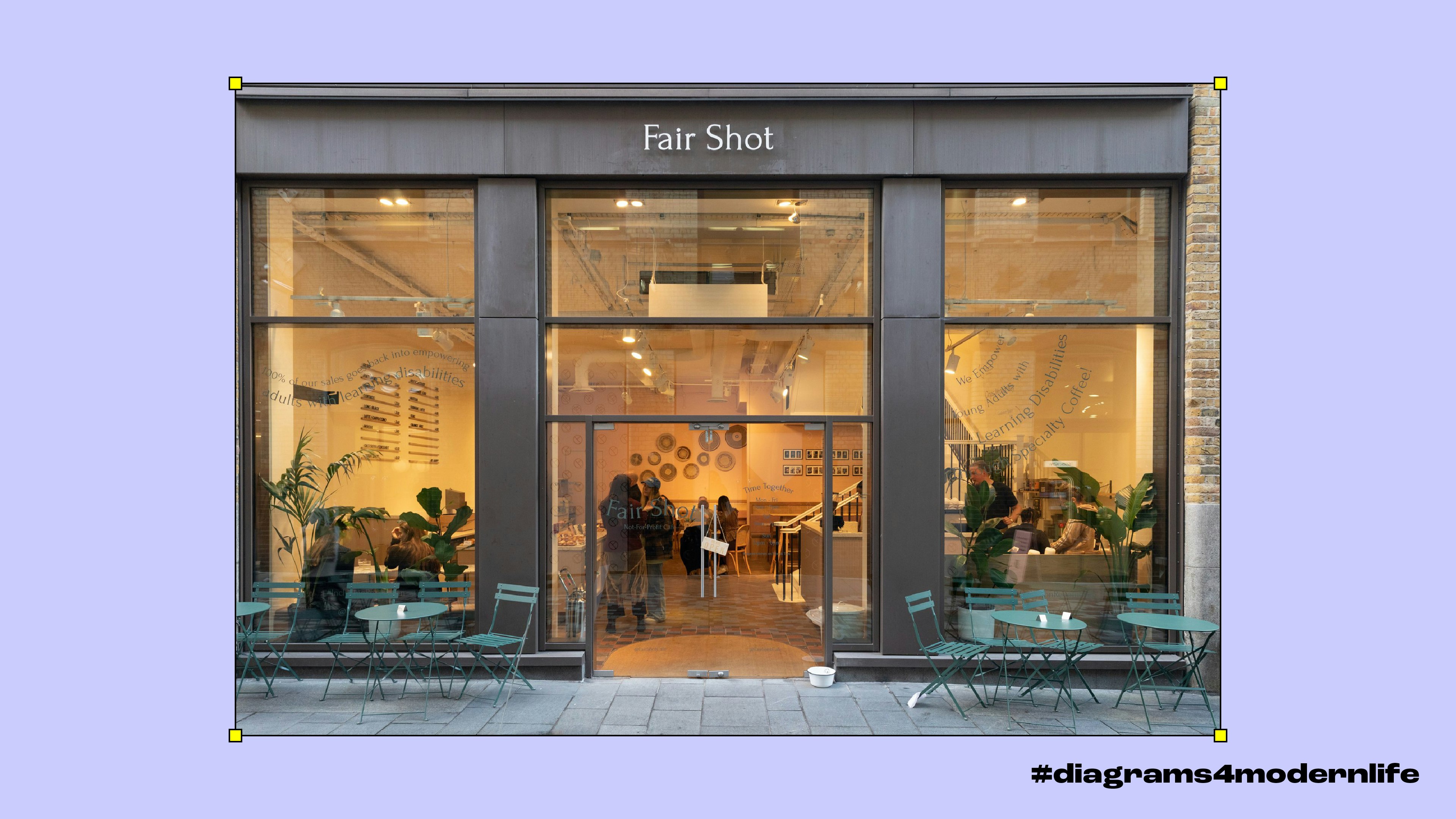#4 Diagrams for Modern Life — Do Good Meeting
Founder / Creative Director
@11:00, 27.02.2024

Every meeting is different. It might be called suddenly or planned weeks in advance. These are some principals I always use to get a good outcome. They’ve been tested on organisations like Doctor Martens, Brompton Bikes, American Express and startups like EXO, Generation Home and Onlia. They work.
Generosity
To put people in a generous mood - willing to help and share and support - put them in a generous environment. Here’s a good example - FAIR SHOT CAFÉ (Above). It’s light, bright and doing something GENEROUS by employing and training people with learning difficulties. If it’s an internal meeting - bring some gifts or give people some time back (Eg. “it’s in the diary for two hours but we can do it in 90 minutes”).
Efficiency
Stealing is efficient. Bezos has done ok so here are his rules for a good meeting:
— Two pizzas - the right number of people in a meeting can be fed by two pizzas (6/8)
— An empty chair - to make sure the customer is represented and front of mind
— The same page - everyone has the same 2 page memo with key points (not a powerpoint)
— 20 minutes - to read and digest the memo and get on the same page

Safety
I’m interviewing entrepreneurs, engineers, marketeers and clients about inventiveness and creative cultures. One thing they all say is “create a safe environment”. So don’t say, “there’s no such thing as a bad idea” and leave it at that. Because:
1. It’s a lie and
2. Safety is not about ideas, it’s about support and respect
Get everyone to share the worst mistake or idea they ever had (work related) and how it led to something better (If they haven’t got a story they probably shouldn't be in the meeting). The best ideas often come from a personal place or observation. Imagine if no one at Pixar had ever said “does anyone ever imagine that when they leave the room their toys come to life?“ So make it ok to get a little weird, personal and specific. (Olympic failure)

Diversity
Get everyone to draw a meeting clock and to keep updating it. This gives participants a framework for listening and recognising their colleagues' idiosyncrasies and decision criteria. Some people see an idea, others feel or hear it. We are all rational, emotional, creative, strategic to different degrees.

Diversity 2: Everyone ‘receives’ differently
There’s a voice in my head (mine) talking to me all the time, rehearsing presentations, going over ideas and scripts for posts, arguing for and against a concept. But apparently 70% of us don't do this. It’s not that 70% aren’t thinking, but our inner monologues are different. I always assumed everyone thinks the WAY (not same as) I do. This statistic reminded me of one of the BEST BITS OF ADVICE I’ve ever been given by Anton Baumohl, a business psychologist. I didn’t always pay as much attention to what he was saying as I should but this stayed with me, “You’ll say something in a meeting to 10 people. Each one of them will interpret it differently.”
You can say "we need to be more transparent" and everyone will nod because it’s a generically ‘good’ value. But it will mean different things to different people. It could be: a lot of additional work, a PR disaster in the making, an amazing opportunity to share work, a great new vein of content to mine, expensive legal fees … So be precise and use specific examples:
Transparent.
Transparent about how we hire people.
Transparent about how we hire people, nurture them and reward them.
Transparent hiring means …
Transparent nurturing means …
Transparent rewarding means …
Walking out of a meeting with agreement around [INSERT VALUE, AMBITION, PROPOSITION HERE] is not a win. Work through and repeat the concepts in pictures, words and actions. How will an idea make people feel? How much will it cost? Do we have the resources to deliver it? Map out the customer journey. Cover all the angles. Allow time for this.

Want to run a really P O S I T I V E meeting?
D I V I D E the room and get 10 X insights. Consensus drains the energy out of a meeting and knocks the edges off of a concept. If you want to get energy in a room and real insight around the potential of an idea - divide and polarise. Give one side the task of defending an idea - whether they like the idea or not, they must work with teammates to build an unassailable fortress around a concept charge the other side with attacking the idea - finding its weaknesses and exploiting them.
Choose the ‘battles’:
– Can we scale this?
– Can we own this?
– Can we take this idea into other products?
– Can we PR this idea?
People just think differently in competitive mode. They are inventive and passionate. And people that like an idea but have to destroy it will see its weaknesses more clearly AND vice versa. By avoiding CONSENSUS you get a much more ROBUST assessment of a concept. Be alive to what's happening in the teams - the different personalities on both sides. The risk takers and the risk averse. Have ‘spies’ in both camps and swap them halfway. It gets electric.
If you’ve created the right environment before this exercise (safe, generous) then it’s incredibly inclusive and constructive. You’ll get 10 X more insights than if you’d gone for consensus.
